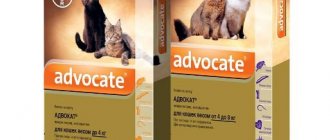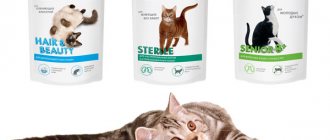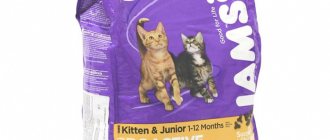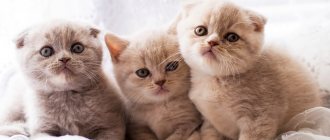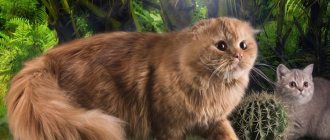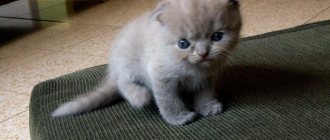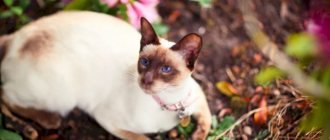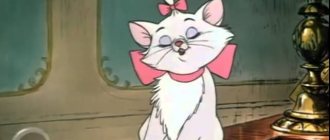Cats have long settled next to humans. People domesticated their wild ancestors in order to obtain help in the fight against rodents and to find docile, harmless companions. Over time, man learned to preserve the necessary qualities of character and color in his offspring. Gradually, new breeds of furry purrs arose. However, outbred cats did not disappear, but gradually filled the space of populated areas around the world. Regardless of their origin, cats remain devoted to their owners and give them their love every day. Today our material is dedicated to outbred furry pets.
Is there a yard breed?
Outbred cats make up 90% of the entire cat population of the planet. And no other breed can boast of such a variety of coat colors, body dimensions and characters as these felines have. The history of coexistence between humans and cats goes back almost 10 thousand years. In that distant time, cats were not divided into breeds. People were more interested in the practical benefits of pets. They have always been valued as excellent hunters of small rodent pests.
At different times, attitudes towards cats were ambiguous. The ancient Egyptians deified these animals, and in medieval Europe they were credited with a connection with evil spirits. Domestic or yard cats, descended from wild ancestors, were common on all continents. Differences in climate and nutrition led to a variety of characters and appearance.
The very concept of “breed” is very young – it is no more than 200 years old. Felinological organizations identify special traits and properties in individual cats, then prescribe and approve a standard with these unique characteristics, thereby giving the world a new purebred beauty.
Felinologists call yard cats outbred, although this statement can be considered erroneous, because the ancestors of all purrs were wild cats, which have different external characteristics and character, which is explained by different climates and ability to adapt.
Thus, native breeds with characteristic external data and character traits can be called yard breeds, because the distinctive characteristics of these purrs were formed thanks to nature, without the “selective” hand of man.
These native barn cats include:
- Turkish Angora.
- Celtic cat.
- Persian cat.
- Siberian cat.
- Siamese cat.
A little cat history
As you know, all modern domestic cats are descended from wild cats. Some breeds are from the inhabitants of the African continent, others are from wild European cats. They were all very different in color:
- The steppe cat (Felis Silvestris Lybica) was striped, with a gray, silver or sandy background. Depending on the subspecies, the color could change to light or dark sandy, and the stripes were replaced by spots;
- The European forest cat (Felis Silvestris) was distinguished by its beautiful grayish color with an ocher tint and dark, clear stripes.
The African steppe cat Felis Silvestris Lybica and its subspecies are considered the progenitors of all domestic cats
These cats served as the basis for the entire cat family. It is quite possible that during the formation process, interspecific crossing and gene mutations occurred, which further diversified the colors.
About 5,000 years ago, cats were domesticated by humans. Since then, thanks to selection and the same crossing, the colors of cats have become even more diverse.
For domestic cats, there are two basic colors: red and black. They form almost all colors in various combinations and variants. In turn, their manifestation is due to the pigment melanin. Eumelanin is responsible for black fur, and pheomelanin is responsible for red fur. Depending on the number of melanin granules in the hair, the color can be more or less intense.
All cat colors are formed using two pigments.
Black colors
Black colors are also called eumelanistic. The genes for black colors look like this:
- B - black;
- b - brown;
- bl - brown light.
They are combined in twos on a chromosome and are called alleles. So:
- a pair of explosives is responsible for the black color,
- bb - for chocolate and purple,
- blbl forms cinnamon and fawn.
Gene B is stronger than b, and b, in turn, is stronger than bl. Therefore, in the Bb pair the cat will be black, in the bbl pair - chocolate, in the Bbl pair - black again.
There is also an intensity gene on the chromosome. It will form the following colors:
- ВВDD - black solid (saturated),
- BBdd - blue,
- BBDd - black (since the D gene is dominant).
Many colors come from black
Red colors
The second name for red colors is pheomelanistic. The genes for red colors are dominant O and recessive O. In combination with genes D and d they produce:
- OD - rich red,
- Od - creamy.
The red color differs depending on the gender of the cat. This is due to its binding to the X chromosome. So, if a cat (XY) has the gene for red color, he will be red. In order for a cat (XX) to be red, it must have the red gene on both chromosomes.
Red color is the result of the action of pheomelanin
White color
The white color of cats is formed using the W (dominant) and w (recessive) genes. It acts by suppressing the genes of other colors. The W gene itself is not a color gene: it is precisely a suppressor gene that prevents the release of pigment.
If two cats with the WW (dominant) gene are crossed, the kittens will only be white. If you cross two cats with the Ww gene (such individuals are called heterozygous, that is, having two different alleles in one gene), then pigment may also appear in the offspring.
A big problem for white cats, especially blue-eyed ones, is deafness. It does not affect all animals, but occurs in almost 45% of cases. This occurs because the hearing loss gene is linked to the W (solid white) gene or the S gene (white spot gene).
White cats are not necessarily albinos
Cats have been with humans for more than 9,000 years, as evidenced by archaeological research and ancient writings. And in those days, no one thought about whether a cat belonged to a particular breed. In Ancient Egypt, cats were revered as sacred animals and were also valued as excellent rodent hunters.
Since the end of the 19th century, active breeding work has been carried out, which gives birth to more and more new breeds of cats. This produces extraordinary mustaches with varying lengths of fur or even hairless ones, with amazing colors and interesting character traits. Each representative that is recognized by a felinological organization is unique and finds its fans. But with all the variety of purebred purrs, yard cats remain the most numerous and popular.
The difference between purebred and mongrel cats
At first glance, the differences lie on the surface. If a cat has reddish short hair, a characteristic color-point color and bright blue eyes, then no one doubts that this is a purebred Siamese. But brown pupils, a sixth toe or an overly large mask instantly exclude this aristocrat from the purebred group.
Which animals fall under the definition of outbred:
- In the first place is the culling of breeding animals. It includes all individuals that are not suitable for breeding and exhibition. Such cats cannot be called outbred, but they are also not considered to be among the elite cohort.
- Next come the mixed breeds - the owners did not keep track of the walking cat, but she delighted them with mixed offspring. The appearance may be impeccable, a fake pedigree can deceive an expert, but as soon as it comes to kittens, everything immediately falls into place. Mestizos do not guarantee quality children.
- The final group is ordinary outbred cats, at first glance one can immediately identify 10 generations of street strays. They come in all sizes, coat types and colors.
The listed animals belong to the group of domus - good companions for their owners, but without certain characteristics of the breed or with its unconfirmed characteristics.
Red kitten
Then, from somewhere in the neighboring yards, a very small red kitten with round eyes wandered in, screaming incessantly and constantly climbing into places it shouldn’t. If we add to what has been said that he was also stupid and fearless, it is not surprising that his fate turned out to be very tragic.
He lived in the organization's working yard for just over a week. And, probably, over the summer he could have grown into a beautiful and well-fed white and red cat, if one day he had not decided to walk along the upper edge of a two-meter fence that borders the space belonging to the local security guard, who was also on the payroll of the company - Alabai, affectionate towards his own and merciless to everyone else. Alabai, seeing the uninvited visitor, rushed to the fence barking. From the push, the kitten lost its balance and, falling inside, was torn to pieces in a matter of seconds.
Later, work life threw me into “raising” a branch of the company in another city for a whole year, there were other street cats and cats...
Features of the appearance of yard cats
Classification of outbred cats is carried out in standard ways: by weight and size, by coat length, by color.
By weight and size:
- large (over 7 kg);
- medium (4-7 kg);
- small (up to 4 kg).
Additionally, the height and length of a mongrel cat are considered. Sometimes the weight of the animal does not reach the required values due to its light bones, but its body is long and has high legs. Such cats are included in the first group. The same applies to small ones, when small height is compensated by significant weight.
Wool length:
- long-haired;
- semi-longhaired;
- shorthaired
The type of hair in cats is determined by a set of specific genes passed on to them from their parents: the L- allele is an attribute of short hair, and ll characterizes the preference for long and semi-long hair. Depending on the genetic pedigree of mongrel cats, long-haired parents may produce short-haired children.
Among yard four-legged inhabitants, owners of long hair are rarely found. Usually such animals are short-haired. Tailed mongrels, depending on the characteristics of the climate in which they were formed, are conventionally divided into 2 types: northern and southern. The mustachioed “northerners” have long, thick hair, while the “southerners” have short hair without a pronounced undercoat layer. It is impossible to meet a hairless barn cat. Even if a street kitten is born completely hairless, it is unlikely to live long in harsh conditions.
In color, the genotype also comes first. It is impossible to guess the color of the offspring of outbred cats in advance, and no one sets such a task.
The colors of the fur of yard cats are so varied that purebred individuals can envy them. There are animals that have a spotted color, which represents entire patterns. Among outdoor cats you can often see tri-colored ones. This suit has been considered lucky for a long time. Despite the variety of colors, the most common is light wool with dark stripes.
Street cats almost never produce kittens of rare exotic colors. For example, marble color (tbtb allele) exists only in a recessive form - it is suppressed by other genes. The probability of meeting two outbred cats with this genotype is close to zero.
A bit of genetics
White color
Cats that do not belong to any particular breed make up almost 90% of the world's purring population. Tamed by the ancient Egyptians, these animals faithfully serve man to this day.
Outbred cats are the most numerous representatives of their kind
Since the purr was loved not only in the Nile Valley, but throughout the globe, in different parts of the planet domuses (as domestic mongrel felinologists call them) began to look different over time.
Currently, experts classify simple fluffy cats living in apartments as either a street breed (a cross between several breeds, in the formation of which humans no longer participated) or a street-aboriginal breed (when yard cats descend from wild local purrs). The latter are divided into the following varieties:
- Celtic cats (European shorthair);
- Siamese cats;
- Angora cats;
- Persian cats;
- Siberian cats.
Initially, people were not involved in the selection of street fluffies, so among these purrs there are both blue-eyed and green-eyed beauties. The tails of mixed-breed cats can be either long or short, which is also true for the ears and the body as a whole.
The appearance of outbred cats is influenced by their habitat and climate. Thus, northern murkas are distinguished by their massive build and long hair with a thick undercoat. And on the southern shores, graceful and slender seals with short, easily blown fur are more common. And the weight of smooth-haired Domus is no more than 6 kg.
The length of the fur of outdoor cats depends on the climate
The specificity of origin also affects the process of pigmentation of the coat of a mongrel cat. Among the representatives of the species there are both spotted and monochromatic purrs. The palette of colors amazes the imagination with its diversity - here you can find red cats, black, gray, and even happy tri-colored ones.
We suggest you read: What causes kidney disease in cats?
Thus, despite the unflattering name, a simple street kitten may well grow into a beautiful and graceful animal with an unusual fur coat and bright eyes. The main thing is to show him due care and attention.
Tortoiseshell color is not uncommon among outbred cats Black street cats are dexterous night hunters Red cats have long been considered protectors from witchcraft Gray coat color is an ideal way of camouflage Tricolor cats are a good luck charm for many pet lovers White cats are the rarest among outbreds
Character of outbred purrs
Where yard cats have a clear advantage over purebred cats is in their character traits and attitude towards their owners. By adopting a mongrel kitten, you can be sure that a creature has settled in the house who will be grateful to you all its life.
Outbred cats are restrained in showing emotions. It is as difficult to predict a pet's character as it is to predict its appearance. Some can be curious and restless. Others behave like born aristocrats, showing honor by the very fact of their existence.
Health and life expectancy
Most four-legged street dwellers are in good health and free of any genetic diseases. This feature was formed over centuries in wild conditions and was passed on to modern domesticated outbred cats.
Strong immunity is the basis for the long life of tailed mongrels (which does not negate the need for their vaccination and treatment for parasites). On average they live about 10–12 years. Among them there are often true centenarians, living up to 16–17 years.
Domestic mongrel pets usually live much longer than their counterparts who were not lucky enough to find loving owners. This is influenced by a well-fed life, regular care and the opportunity to use veterinary help in case of illness. Street animals must search for food on their own and often die, unable to cope with disease and hunger, becoming a victim of a dog attack or freezing to death.
Pet care
To comfortably accommodate a mongrel animal, you need:
- arrange a sleeping place for him in a warm, quiet room, where there are no drafts;
- tray with or without filler;
- scratching post;
- bowls for food and water;
- walking harness;
- play complex and (or) toys.
Yard cats also need the care and attention of their owners:
- Grooming . The coat needs to be brushed regularly. The frequency of the procedure depends on the length of the animal's fur. For short-haired dogs, it is enough to do this 2 times a month, and for long-haired dogs, once a week.
- Eye care . They need to be inspected and wiped with a damp swab when dirty.
- Water treatments . There are very few cats that favor this process, so you should not bathe your pet too often. Usually mongrels themselves monitor the cleanliness of their fur. If the cat returns dirty after active street festivities, you can give it a bath.
- Nutrition . It should be balanced and include both proteins (meat, fish, eggs, fermented milk) and carbohydrates (porridge, vegetables, crackers, root vegetables).
Making a new friend
The undoubted advantage of outbred cats is that no costs are required to purchase them. Usually such pets are acquired through friends or through an advertisement. Often, stray kittens are picked up on the street. If an animal is taken from home and there is a choice, in order not to make a mistake with the character and health of the kitten, you need to take a closer look at the following signs:
- the kitten readily approaches you, tries to flirt and does not try to show aggressiveness;
- the kitten is distinguished by its external attractiveness, meekness, agility, playfulness, playfulness and does not look sad, dejected or apathetic;
- holds his head up normally and walks or runs with absolutely no limp;
- does not twitch his head, does not have a runny nose, cough, or other external painful signs;
- the kitten's skin looks clean and healthy, without irritation, dirt, scabs or flea excrement;
- the animal's coat is shiny and clean, without bald spots or tangles (matted);
- no liquid or other discharge from the eyes, nose and ears;
- the third eyelid (the so-called nictitating membrane) does not cover part of the eye;
- teeth look clean and free of tartar, there is no unpleasant odor from the mouth;
- The gums of a healthy kitten are pink and there are no signs of bleeding;
- the stomach feels quite strong and at the same time not bloated;
- the anus is clean, without remains of feces, there are no visible signs of diarrhea or worm segments (they, if present, come out of the anus and look like grains of rice).
We recommend reading: Beauceron: everything about the dog, photo, description of the breed, character, price
It is recommended to wean a kitten from its mother no earlier than 2.5–3 months. At this age, the baby will tolerate separation without consequences for the psyche. He is already accustomed to the tray and “adult” food.
Cats are considered social animals. Therefore, experienced felinologists recommend, if possible, purchasing two kittens at once. For the company. Especially if the owners have to be away from home for a long time.
The offspring of outbred cats can be of a wide variety of colors
Cleanliness is the key to cat health
Caring for the appearance of a mongrel pet will not cause much trouble. The coat should be combed 1-2 times a week with a stiff brush to remove dead hair. During molting - 2-3 times. To avoid ear mites, wipe your ears with a cloth moistened with hydrogen peroxide. Use special ear drops. Remove discharge from the eyes with a soft cloth. Train your kitten to use a scratching post. This will save you and your cat from the unpleasant procedure of trimming its claws. You need to bathe your pet as soon as it gets dirty. But not often. Cats take care of their fur coats themselves. Almost everyone, with rare exceptions, does not like water procedures.
A good toilet for your beloved cat
When choosing a toilet for a kitten, focus on an adult cat, so as not to buy a new one when it grows up. The pet must enter it entirely. The height of the sides is not lower than 6 cm. It is better to use clumping filler for the tray. It absorbs odor well and simplifies the cleaning process. If finances allow, then the best option would be a box (dry toilet) with replaceable cassettes.
Light and air
Outdoor cats need fresh air and sunlight. Ultraviolet light promotes the production of vitamin B. If your pet constantly lives in an apartment, surprise him - in good weather, take him for a walk in the nearest park or forest. Use a harness with a leash for this. Avoid asphalt. For delicate cat paws, soft soil or grass is better. Try to avoid crowded areas of cars, people and dog walking so as not to scare your pet.
Advantages and disadvantages
Despite the fact that yard cats do not have such exclusive characteristics as their purebred counterparts, they are nevertheless not without merit.
- Lasting immunity. Breeding breeds using selective breeding methods has greatly weakened the immune system of animals. This is why the life expectancy of street cats is many times higher than that of purebred pets. Yard cats have strong protective functions of the body and are able to resist many infections.
- Personality Such animals tend to be docile in nature. They become very attached to the owner who picked them up on the street.
- Reproduction. Since yard cats do not need a purebred partner, finding a mate for them to reproduce will not be difficult.
- Indispensable in the household. Outdoor cats are excellent mouse hunters. Nature endowed the animal with these qualities, and it is among the domestic representatives of the family that this instinct is much more developed.
- Price. You don't need a big investment to get a pet. You can pick up a cute, albeit not purebred, kitten on the street. Some cats even choose their own owner, coming to visit and “imposing” themselves.
- Exhibitions for yard cats. You heard right. Indeed, there are special exhibitions designed for outbred cats. On them, judges evaluate the external characteristics of the animal and its grooming.
The main and, perhaps, the only drawback of street cats is their unpredictability of character. Stray cats are careful in expressing their emotions, therefore, when taking such an animal from the street, you cannot be sure that it has a calm, easy-going disposition. Otherwise, mustachioed-striped tramps successfully compete with their purebred brothers.
Reviews
In every third family where pets live in Russia, these are outbred animals. The owner reviews below indicate that the cat is a social animal, the best companion with a minimum of comfort.
- “We adopted a calico cat when she was still a baby. Believe it or not, my husband immediately got a job. And the cat is also an excellent doctor, she lay next to me during a migraine, everything went away without pills! She is our most faithful friend."
- “Our cat is a pigeon hunter. As soon as the family gathered at the table, they made their contribution in the form of a bird. Not a single purebred cat can compare with her; she even goes to the toilet, and then flushes after herself, jumping on the button of the tank. Have you seen this? »
- “A beloved cat is like security. We took a stray kid from the dacha, he’s been sleeping with us for seven years now, he doesn’t like guests, he’s not afraid of dogs, but he chases them away. Not picky about food at all! There is no one better than an ordinary cat in the world!”
- “a beautiful creature who thanked us for our attention with love. It is not inferior in intelligence and intelligence to a purebred cat, rather superior. No endless visits to the veterinarian, bathing, expensive food.”
- “I don’t see the point in paying for a purebred animal and then taking it and money to veterinarians, pet supply retailers, etc. Our Nyusha - we took her from an advertisement - is very smart, always feels the mood, will console you in sadness, support you in joy.”
Choosing a purebred cat
The decision is best made after the consent of all family members. Attention is drawn to the following circumstances:
- Age. A young cat will more easily enter a new environment and adapt to it. She had not yet developed the habits of a wandering life, and her character had not hardened in the struggle for survival.
- Health. Ordinary street kittens traditionally have strong immunity and natural endurance. A healthy kitten should be playful, easy to run and jump, with shiny, even fur, pink gums and clean mucous membranes.
Appearance also plays a role in the selection process. They look at her first of all - after all, the aesthetic desire to own a beautiful animal overshadows everything.
The task is greatly simplified when it comes to the children of a domestic mongrel cat. Here the parents are already known (at least one of them), the kitten is under supervision and warm, and the mother cat has adequate feeding and the opportunity to raise her offspring.
If you pick up a mongrel kitten on the street, you risk bringing a sick animal into your home. Be sure to take him to the vet right away. A little street child may have lichen or fleas. It may be infected with an infection or worms. If a purebred parent took part in the birth of a kitten, then, in addition to distinctive features, the baby can inherit genetic diseases inherent in the breed.
How to train to a tray?
After a few explanations, the baby will master his new toilet. When buying a toilet, it is recommended to focus on an adult cat, so that you do not have to choose a new litter tray when the kitten grows up. As a filler, it is recommended to use one that clumps. According to the description of the properties, the product reliably absorbs moisture and prevents unpleasant odors from spreading throughout the room. It is enough to show the kitten the tray 1-2 times, and he will immediately understand its purpose.
